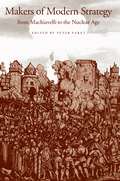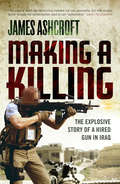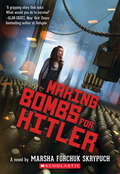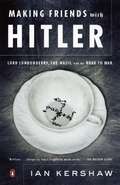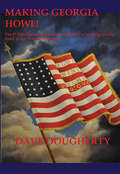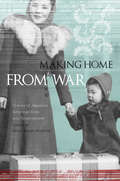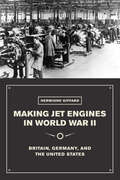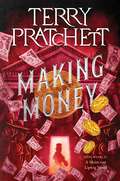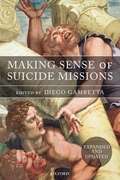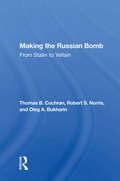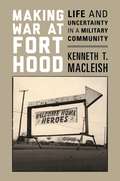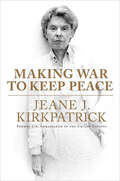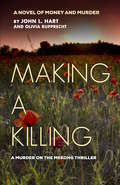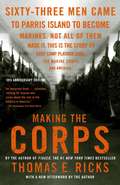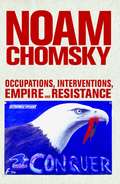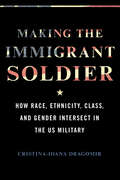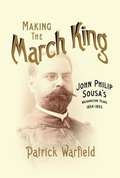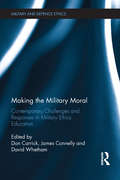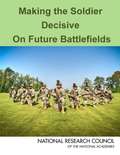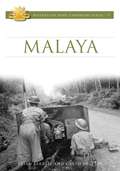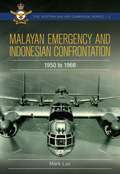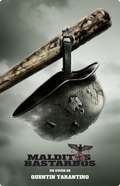- Table View
- List View
Makers of Modern Strategy from Machiavelli to the Nuclear Age: from Machiavelli to the Nuclear Age
by Russell F. WeigleyThe classic reference volume on the theory and practice of warThe essays in this volume analyze war, its strategic characterisitics, and its political and social functions over the past five centuries. The diversity of its themes and the broad perspectives applied to them make the book a work of general history as much as a history of the theory and practice of war from the Renaissance to the present. Makers of Modern Strategy from Machiavelli to the Nuclear Age takes the first part of its title from an earlier collection of essays, published by Princeton University Press in 1943, which became a classic of historical scholarship. Three essays are repinted from the earlier book while four others have been extensively revised. The rest—twenty-two essays—are new.The subjects addressed range from major theorists and political and military leaders to impersonal forces. Machiavelli, Clausewitz, and Marx and Engels are discussed, as are Napoleon, Churchill, and Mao. Other essays trace the interaction of theory and experience over generations—the evolution of American strategy, for instance, or the emergence of revolutionary war in the modern world. Still others analyze the strategy of particular conflicts—the First and Second World Wars—or the relationship between technology, policy, and war in the nuclear age. Whatever its theme, each essay places the specifics of military thought and action in their political, social, and economic environment. Together, the contributors have produced a book that reinterprets and illuminates war, one of the most powerful forces in history and one that cannot be controlled in the future without an understanding of its past.
Making A Killing: The Explosive Story of a Hired Gun in Iraq
by James AshcroftIn September 2003, James 'Ash' Ashcroft, a former British Infantry Captain, arrived in Iraq as a 'gun for hire'. It was the beginning of an 18-month journey into blood and chaos.In this action-packed page-turner, Ashcroft reveals the dangers of his adrenalin-fuelled life as a security contractor in Baghdad, where private soldiers outnumber non-US Coalition forces in a war that is slowly being privatised. From blow-by-blow accounts of days under mortar bombardment to revelations about life operating deep within the Iraqi community, Ashcroft shares the real, unsanitised story of the war in Iraq - and its aftermath - direct from the front line.
Making Bombs for Hitler
by Marsha Forchuk SkrypuchLida thought she was safe. Her neighbors wearing the yellow star were all taken away, but Lida is not Jewish. She will be fine, won't she?But she cannot escape the horrors of World War II. Lida's parents are ripped away from her and she is separated from her beloved sister, Larissa. The Nazis take Lida to a brutal work camp, where she and other Ukrainian children are forced into backbreaking labor. Starving and terrified, Lida bonds with her fellow prisoners, but none of them know if they'll live to see tomorrow. When Lida and her friends are assigned to make bombs for the German army, Lida cannot stand the thought of helping the enemy. Then she has an idea. What if she sabotaged the bombs. . . and the Nazis? Can she do so without getting caught?And if she's freed, will she ever find her sister again?This pulse-pounding novel of survival, courage, and hope shows us a lesser-known piece of history -- and is sure to keep readers captivated until the last page.
Making British Defence Policy: Continuity and Change (Routledge Advances in Defence Studies)
by Robert SelfThis book explores the process by which defence policy is made in contemporary Britain and the institutions, actors and conflicting interests which interact in its inception and continuous reformulation. Rather than dealing with the substance of defence policy, this study focuses upon the institutional actors involved in this process. This is a subject which has commanded far more interest from public, Parliament, government and the armed forces since the protracted, bloody and ultimately unsuccessful British military involvement in Iraq and Afghanistan. The work begins with a discussion of two contextual factors shaping policy. The first relates to the impact of Britain’s ‘special relationship’ with the United States over defence and intelligence matters, while the second considers the impact of Britain’s relatively disappointing economic performance upon the funding of British defence since 1945. It then goes on to explore the role and impact of all the key policy actors, from the Prime Minister, Cabinet and core executive, to the Ministry of Defence and its relations with the broader ‘Whitehall village’, and the Foreign Office and Treasury in particular. The work concludes by examining the increasing influence of external policy actors and forces, such as Parliament, the courts, political parties, pressure groups and public opinion. This book will be of much interest to students of British defence policy, security studies, and contemporary military history.
Making Friends with Hitler: Lord Londonderry, the Nazis and the Road to World War II
by Ian KershawCharles Stewart Henry Vane-Tempest-Stewart, the 7th Marquess of Londonderry, was born to power and command. Scion of one of Britain's most aristocratic families, cousin of Churchill and confidant of the king, owner of vast coal fields and landed estates, married to the doyenne of London's social scene, Londonderry was an ornament to his class, the 0. 1 percent of the population who still owned 30 percent of England's wealth as late as 1930. But history has not been kind to "Charley," as the king called him, because, in his own words, he "backed the wrong horse," and a very dark horse indeed: Adolf Hitler and his Nazi Party. Londonderry was hardly the only British aristocrat to do so, but he was the only Cabinet member to do so, and it ruined him. In a final irony, his grand London house was bombed by the German Luftwaffe in the blitz. Ian Kershaw is not out to rehabilitate Lord Londonderry but to understand him and to expose why he was made a scapegoat for views that were much more widely held than anyone now likes to think. H. L. Mencken famously said that "for every complex problem, there is a solution that is simple, neat, and wrong. " The conventional explanation of the coming of World War II is a simple story of the West's craven appeasement of Hitler in the face of his bullying. Through the story of how Lord Londonderry came to be mixed up with the Nazis and how it all went horribly wrong for him, Ian Kershaw shows us that behind the familiar cartoon is a much more complicated and interesting reality, full of miscalculations on both sides, miscalculations that proved to be among the most fateful in history.
Making Georgia Howl!: The 5th Ohio Volunteer Cavalry in Kilpatrick's Campaign & the Diary of Sgt W.H. Harding
by Dave DoughertyThe 5th Ohio Volunteer Cavalry Regiment fought over three years, from March 1862 to General Johnson’s surrender in April 1865. It played a major role in Kilpatrick’s Cavalry Corps on Sherman’s March to the Sea; told as an overview of operations and through the diary of Sergeant William H. Harding. Confederate histories have often reported the regiment decimated and defeated in every battle, but this study presents the truth of the matter for the first time. Fighting in Judson Kilpatrick’s 3rd Cavalry Division during Sherman’s campaign through Georgia and the Carolina’s doing everything that could be expected of them and acquitted themselves honorably against the Confederate commanders – Joseph Wheeler and Wade Hampton. This volume is the definitive study of the 5th Ohio and Kilpatrick’s campaign in Sherman’s army from Atlanta to the end of the war. Bonuses include the diary and letters of Commissary Sergeant William H. Harding present in Company K of the 5th OVC from August 1862 to July 1865.
Making Home From War: Stories of Japanese American Exile and Resettlement
by Brian DempsterMany books have chronicled the experience of Japanese Americans in the early days of World War II, when over 120,000 persons of Japanese ancestry, two-thirds of whom were American citizens, were taken from their homes along the West Coast and imprisoned in concentration camps. When they were finally allowed to leave, a new challenge faced them—how do you resume a life so interrupted? For most, going home meant learning to live in a hostile, racist environment. Some returned to find they had lost their homes and had little choice but to bide their time in transitional housing, including community halls, churches, housing projects, and tent camps. Their employment options were also limited; they often worked as domestics, dishwashers, and field laborers to help support their families. The effects of these experiences reverberate to this day, and Making Home from War reaches into the past, melds together what was once hidden, and tells the often neglected or hushed story of what happened after the war. <P><P>With honesty and an eye for detail, Making Home from War is the long-awaited sequel to the award-winning From Our Side of the Fence. Written by twelve Japanese American elders who gathered regularly at the Japanese Cultural and Community Center of Northern California, Making Home from War is a collection of stories about their exodus from concentration camps into a world that in a few short years had drastically changed. In order to survive, they found the resilience they needed in the form of community, and gathered reserves of strength from family and friends. Through a spectrum of conflicting and rich emotions, Making Home from War demonstrates the depth of human resolve and faith during a time of devastating upheaval.
Making Jet Engines in World War II: Britain, Germany, and the United States
by Hermione GiffardOur stories of industrial innovation tend to focus on individual initiative and breakthroughs. With Making Jet Engines in World War II, Hermione Giffard uses the case of the development of jet engines to offer a different way of understanding technological innovation, revealing the complicated mix of factors that go into any decision to pursue an innovative, and therefore risky technology. Giffard compares the approaches of Britain, Germany, and the United States. Each approached jet engines in different ways because of its own war aims and industrial expertise. Germany, which produced more jet engines than the others, did so largely as replacements for more expensive piston engines. Britain, on the other hand, produced relatively few engines--but, by shifting emphasis to design rather than production, found itself at war's end holding an unrivaled range of designs. The US emphasis on development, meanwhile, built an institutional basis for postwar production. Taken together, Giffard's work makes a powerful case for a more nuanced understanding of technological innovation, one that takes into account the influence of the many organizational factors that play a part in the journey from idea to finished product.
Making Money: A Discworld Novel (Moist von Lipwig #2)
by Terry Pratchett“Outlandish fun. . . . Making Money balances satire, knockabout farce and close observation of human—and non-human—foibles with impressive dexterity and deceptive ease. The result is another ingenious entertainment from the preeminent comic fantasist of our time.”—Washington PostThe hero of Going Postal has an even more dangerous job than the mail: overseeing the tanking Royal Bank and the printing of Ankh-Morpork’s first paper currency in this brilliant installment in New York Times bestselling author Sir Terry Pratchett’s beloved Discworld series.The Royal Bank of Ankh-Morpork is facing a crisis, and who better to manage it than the man who turned around Ankh-Morpork’s inefficient Post Office, former arch-swindler-turned-Postmaster General Moist von Lipwig. Lord Vetinari once again makes Moist an offer he can’t refuse: resuscitate the venerable Royal Mint.The bank has many problems: the chief cashier is almost certainly a vampire, the elderly chairman and her two loaded crossbows needs a daily walkie, there’s something strange happening in the cellar, and running the Royal Mint is costing a mint.As Moist begins to make some ambitious changes, he accrues some dangerous enemies. Everyone knows money is power—and certain stakeholders will do anything to keep a firm grip on both . . .The Discworld novels can be read in any order, but Making Money is the second book in the Moist von Lipwig series. The full series, in order, includes:Going PostalMaking MoneyRaising Steam
Making Sense of Ballistic Missile Defense: An Assessment of Concepts and Systems for U.S. Boost-Phase Missile Defense in Comparison to Other Alternatives
by Committee on an Assessment of Concepts Systems for U.S. Boost-Phase Missile Defense in Comparison to Other AlternativesThe Committee on an Assessment of Concepts and Systems for U. S. Boost-Phase Missile Defense in Comparison to Other Alternatives set forth to provide an assessment of the feasibility, practicality, and affordability of U. S. boost-phase missile defense compared with that of the U. S. non-boost missile defense when countering short-, medium-, and intermediate-range ballistic missile threats from rogue states to deployed forces of the United States and its allies and defending the territory of the United States against limited ballistic missile attack. To provide a context for this analysis of present and proposed U. S. boost-phase and non-boost missile defense concepts and systems, the committee considered the following to be the missions for ballistic missile defense (BMD): protecting of the U. S. homeland against nuclear weapons and other weapons of mass destruction (WMD); or conventional ballistic missile attacks; protection of U. S. forces, including military bases, logistics, command and control facilities, and deployed forces, including military bases, logistics, and command and control facilities. They also considered deployed forces themselves in theaters of operation against ballistic missile attacks armed with WMD or conventional munitions, and protection of U. S. allies, partners, and host nations against ballistic-missile-delivered WMD and conventional weapons. Consistent with U. S. policy and the congressional tasking, the committee conducted its analysis on the basis that it is not a mission of U. S. BMD systems to defend against large-scale deliberate nuclear attacks by Russia or China. Making Sense of Ballistic Missile Defense: An Assessment of Concepts and Systems for U. S. Boost-Phase Missile Defense in Comparison to Other Alternatives suggests that great care should be taken by the U. S. in ensuring that negotiations on space agreements not adversely impact missile defense effectiveness. This report also explains in further detail the findings of the committee, makes recommendations, and sets guidelines for the future of ballistic missile defense research.
Making Sense of Suicide Missions
by Diego GambettaBased on a wealth of original information and research, and containing contributions from internationally distinguished scholars, 'Making Sense of Suicide Missions' furthers our understanding of this chilling feature of the contemporary world in radically new and unexpected ways.
Making The Russian Bomb: From Stalin To Yeltsin
by Thomas B. CochranThe Natural Resources Defense Council once again provides the definitive account of the current status of Russian nuclear weapons. Taking advantage of previously unavailable information the authors describe the origins, growth, and decline of the massive Soviet nuclear weapons production complex-the places involved in the recent headline-making epi
Making Twenty-First-Century Strategy: An Introduction to Modern National Security Processes and Problems
by Donald M. Snow Dennis M. DrewMaking Twenty-first-century Strategy: An Introduction to Modern National Security Processes and Problems
Making War at Fort Hood: Life and Uncertainty in a Military Community
by Kenneth T. MacLeishAn intimate look at war through the lives of soldiers and their families at Fort HoodMaking War at Fort Hood offers an illuminating look at war through the daily lives of the people whose job it is to produce it. Kenneth MacLeish conducted a year of intensive fieldwork among soldiers and their families at and around the US Army's Fort Hood in central Texas. He shows how war's reach extends far beyond the battlefield into military communities where violence is as routine, boring, and normal as it is shocking and traumatic.Fort Hood is one of the largest military installations in the world, and many of the 55,000 personnel based there have served multiple tours in Iraq and Afghanistan. MacLeish provides intimate portraits of Fort Hood's soldiers and those closest to them, drawing on numerous in-depth interviews and diverse ethnographic material. He explores the exceptional position that soldiers occupy in relation to violence--not only trained to fight and kill, but placed deliberately in harm's way and offered up to die. The death and destruction of war happen to soldiers on purpose. MacLeish interweaves gripping narrative with critical theory and anthropological analysis to vividly describe this unique condition of vulnerability. Along the way, he sheds new light on the dynamics of military family life, stereotypes of veterans, what it means for civilians to say "thank you" to soldiers, and other questions about the sometimes ordinary, sometimes agonizing labor of making war.Making War at Fort Hood is the first ethnography to examine the everyday lives of the soldiers, families, and communities who personally bear the burden of America's most recent wars.
Making War to Keep Peace: Trials and Errors in American Foreign Policy from Kuwait to Baghdad
by Jeane J. KirkpatrickWith the powerful words that marked her long and distinguished career, Jeane J. Kirkpatrick explores where America has gone wrong—and raises lingering questions about what perils tomorrow might hold. In Making War to Keep Peace, the former U.S. Ambassador to the UN traces the course of diplomatic initiatives and armed conflict in Iraq, Somalia, Haiti, Bosnia, and Kosovo to illuminate the dangerous shift from the first Bush administration's ambitious vision of a New World Order to the overambitious nation-building efforts of the Clinton administration. Kirkpatrick questions when, how, and why the United States should resort to military solutions—especially in light of the George W. Bush administration's challenging war in Iraq, about which Kirkpatrick shares her "grave reservations" for the first time.
Making a Killing
by John L. Hart Olvia RupprechtThe CIA's most valuable assassin, Agent J.D. Mikel, wasn't supposed to fall in love with anyone - especially not Kate Morningside, a woman coveted by another powerful world player. When Kate is kidnapped, J.D. is pulled into a dangerous game of cat and mouse, and one false move could cost him everything. Indeed, there are players - and then there are the masters who make the rules only to break them. It's not an even match for those joining an epic search for Kate on a twisted dark hunt down the Mekong River in the midst of a bitterly disputed war: Izzy, a brilliant young psychiatrist assigned to the Army's 8th Field Hospital and counting the days until he can return home; and his best friend Gregg, a gifted psychologist who served his time only to be driven back to Vietnam by his own inner demons and a rivalry with Mikel that burns as intensely as napalm. There are other wars within wars in turbulent 1970. From the CIA to the American mafia to an International cartel helmed by a master of the sadistic, all eyes are on Southeast Asia's Golden Triangle. And when it comes to a certain cash crop flourishing under the dominion of the mysterious Poppy King, everyone wants a piece of the action. Money talks. The currency? Heroin. It's a spinning maze of intrigue, politics, and mind games; a hotbed where sex, drugs, and Janis Joplin aren't always a beautiful thing. But even when no one turns out to be quite who or what they seem, one rule remains fast across the Devil's chessboard: Winners live. Losers die. The sequel to the national bestseller THERE WILL BE KILLING, MAKING A KILLING artfully weaves a spellbinding tapestry of dark history, psychology, and seduction - the best and worst of our humanity . . . and the hunger of our hearts. PRAISE FOR THERE WILL BE KILLING: "A riveting journey into the perils of war and the darkness of the human heart - stylish and provocative." - Tara Janzen, New York Times bestselling author "There Will Be Killing is mesmerizing...a chilling and astonishing novel by authors who know their way around a story." - Peggy Webb, USA Today bestselling author of The Language of Silence "Make sure you have some time to spend because you won't want to put it down until you turn the last page." - Book Bug
Making the Corps: 61 Men Came to Parris Island to Become Marines
by Thomas E. RicksThe United States Marine Corps, with its proud tradition of excellence in combat, its hallowed rituals, and its unbending code of honor, is part of the fabric of American myth. Making the Corps visits the front lines of boot camp in Parris Island, South Carolina. Here, old values are stripped away and new Marine Corps values are forged. Bestselling author Thomas E. Ricks follows these men from their hometowns, through boot camp and into their first year as Marines. As three fierce drill instructors fight a battle for the hearts and minds of this unforgettable group of young men, a larger picture emerges, brilliantly painted, of the growing gulf that divides the military from the rest of America. Included in this edition is an all-new afterword from the author that examines the war in Iraq through the lens of the Marines from Platoon 3086, giving readers an on-the-ground view of the conflict from those who know it best
Making the Future: Occupations, Interventions, Empire and Resistance
by Noam ChomskyMaking the Future presents more than fifty concise and persuasively argued commentaries on U.S. politics and policies, written between 2007 and 2011. Taken together, Chomsky's essays present a powerful counter-narrative to official accounts of the major political events of the past four years: the wars in Afghanistan and Iraq; the U.S. presidential race; the ascendancy of China; Latin America's leftward turn; the threat of nuclear proliferation in Iran and North Korea; Israel's invasion of Gaza and expansion of settlements in Jerusalem and the West Bank; developments in climate change; the world financial crisis; the Arab Spring; the assassination of Osama bin Laden; and the Occupy protests. Laced throughout his critiques are expressions of commitment to democracy and the power of popular struggles. "Progressive legislation and social welfare," writes Chomsky, "have been won by popular struggles, not gifts from above. Those struggles follow a cycle of success and setback. They must be waged every day, not just once every four years, always with the goal of creating a genuinely responsive democratic society, from the voting booth to the workplace." Making the Future is a follow-up to Interventions, published by City Lights in 2007 and banned from Guantánamo Bay by U.S. military censors. Both books are drawn from articles Chomsky has been writing regularly for the New York Times Syndicate, but which go largely ignored by newspapers in the United States. Making the Future offers fierce, accessible, timely, gloves-off political writing by one of America's foremost intellectual and political dissidents.
Making the Immigrant Soldier: How Race, Ethnicity, Class, and Gender Intersect in the US Military
by Cristina-Ioana DragomirImmigrants to the United States have long used the armed forces as a shortcut to citizenship. Cristina-Ioana Dragomir profiles Lily, Alexa, and Vikrant, three immigrants of varying nationalities and backgrounds who chose military service as their way of becoming American citizens. Privileging the trio’s own words and experiences, Dragomir crafts a human-focused narrative that moves from their lives in their home countries and decisions to join the military to their fraught naturalization processes within the service. Dragomir illuminates how race, ethnicity, class, and gender impacted their transformation from immigrant to soldier, veteran, and American. She explores how these factors both eased their journeys and created obstacles that complicated their access to healthcare, education, economic resources, and other forms of social justice. A compelling union of analysis and rich storytelling, Making the Immigrant Soldier traces the complexities of serving in the military in order to pursue the American dream.
Making the March King: John Philip Sousa's Washington Years, 1854-1893
by Patrick WarfieldJohn Philip Sousa's mature career as the indomitable leader of his own touring band is well known, but the years leading up to his emergence as a celebrity have escaped serious attention. In this revealing biography, Patrick Warfield explains the making of the March King by documenting Sousa's early life and career. Covering the period 1854 to 1893, this study focuses on the community and training that created Sousa, exploring the musical life of late nineteenth-century Washington, D.C., and Philadelphia as a context for Sousa's development. Warfield examines Sousa's wide-ranging experience composing, conducting, and performing in the theater, opera house, concert hall, and salons, as well as his leadership of the United States Marine Band and the later Sousa Band, early twentieth-century America's most famous and successful ensemble. Sousa composed not only marches during this period but also parlor, minstrel, and art songs; parade, concert, and medley marches; schottisches, waltzes, and polkas; and incidental music, operettas, and descriptive pieces. Warfield's examination of Sousa's output reveals a versatile composer much broader in stylistic range than the bandmaster extraordinaire remembered as the March King. Warfield presents the story of Sousa as a self-made business success, a gifted performer and composer who deftly capitalized on his talents to create one of the most entertaining, enduring figures in American music.
Making the Military Moral: Contemporary Challenges and Responses in Military Ethics Education (Military and Defence Ethics)
by Don Carrick, James Connelly and David WhethamThis book offers a critical analysis, both theoretical and practical, of ethics education in the military. In the twenty-first century, it has become increasingly important to ensure that the armed forces of Western and other democracies fight justly and behave ethically. The ‘good soldier’ has to be not only professionally skilled but morally intelligent. At a time of relentless media scrutiny, the publicising of incidents of morally and legally unacceptable behaviour, such as the gross mistreatment of prisoners and the torture of suspected terrorists, can do much to undermine the credibility of those who claim to hold the moral high ground in any particular conflict. Written by an international team of academic theorists and military practitioners, this volume provides inter-disciplinary insights into the present state, and the future, of ethics education in the militaries of Western democracies. The contributors critically address the central question of whether such education is sufficient to prepare members of the armed forces to face the peculiar challenges of conflict environments that are now primarily ‘wars among the people’, in which the opposing combatants may have little or no regard for human life and fail to discriminate between soldiers and civilians when choosing their targets. Drawing lessons from recent examples of unethical conduct, this original book offers insightful and constructive advice, both theoretical and practical, as to how situations can be improved and on the means that could and should be employed towards this end. This book will be of much interest to students of military studies, ethics and international relations.
Making the Soldier Decisive on Future Battlefields
by Division On Engineering Physical SciencesThe U. S. military does not believe its soldiers, sailors, airmen, and marines should be engaged in combat with adversaries on a "level playing field. " Our combat individuals enter engagements to win. To that end, the United States has used its technical prowess and industrial capability to develop decisive weapons that overmatch those of potential enemies. In its current engagement--what has been identified as an "era of persistent conflict"-- the nation's most important weapon is the dismounted soldier operating in small units. Today's soldier must be prepared to contend with both regular and irregular adversaries. Results in Iraq and Afghanistan show that, while the U. S. soldier is a formidable fighter, the contemporary suite of equipment and support does not afford the same high degree of overmatch capability exhibited by large weapons platforms--yet it is the soldier who ultimately will play the decisive role in restoring stability. Making the Soldier Decisive on Future Battlefields establishes the technical requirements for overmatch capability for dismounted soldiers operating individually or in small units. It prescribes technological and organizational capabilities needed to make the dismounted soldier a decisive weapon in a changing, uncertain, and complex future environment and provides the Army with 15 recommendations on how to focus its efforts to enable the soldier and tactical small unit (TSU) to achieve overmatch.
Malaya 1942 (Australian Army Campaigns Series #5)
by Brian Farrell Gareth PrattenWhen Imperial Japan unleashed the Pacific War in December 1941, Australian forces went into action, as part of a larger British Empire force, to defend Malaya and Singapore. Australia's principal contribution to defending Malaya and Singapore was the 8th Division. Originally raised for service in the Mediterranean, the division was committed piecemeal to Malaya and its performance was bedevilled by poor command decisions in the face of an enemy better prepared on all counts for the campaign at hand. The 8th Division, however, also reflected some strengths of the AIF at large: stubbornness in positional defence, effective and flexible small unit tactics and leadership, and skill and determination in close quarter combat. Singapore was lost more in spite than because of Australian efforts, but its loss underlined Australia's strategic dependence on `great and powerful friends' during the Second World War.
Malayan Emergency and Indonesian Confrontation: 1950-1966
by Mark LaxAustralia&’s involvement in the Malayan Emergency from 1950 to 1960 and later in a confrontation with Indonesia in the 1960s is little remembered today. Yet the deployment of over a third of the RAAF to support the British and Malayan governments in what became a long war of attrition against communist insurgents in the former case, and against Indonesian regulars and militia in the latter, kept the RAAF engaged for over 15 years. Wars by another name, these two events led to the birth of Malaysia and the establishment of an ongoing RAAF presence in South East Asia. Until recent operations in Afghanistan, the Malaya Emergency was Australia&’s longest conflict. Malayan Emergency and Indonesian Confrontation recounts the story of the politics, strategies and operations that brought these two conflicts to a close.
Malditos Bastardos
by Quentin TarantinoDurante la II Guerra Mundial, un pelotón de soldados judíoamericanos conocidos como «Los Bastardos» son seleccionados para sembrar el terror a lo largo y ancho del Tercer Reich. Su misión: asesinar tantos nazis como puedan. Sus métodos: todo está permitido. Todo es válido. Ojo por ojo, diente por diente. Hitler no sabe lo que le espera.
